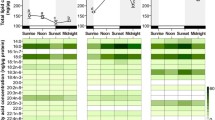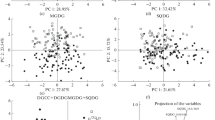Summary.
Preparation of homogeneous endoderm cells and culture is a prerequisite to understanding the cellular and molecular mechanism of endosymbiosis in the cnidarian-dinoflagellate association. During the cell isolation from the stony coral Euphyllia glabrescens, various amounts of symbiotic endoderm cells were found to release their symbionts (Symbiodinium spp., or zooxanthellae in generic usage) into the culture. Due to the bulky occupation by zooxanthellae inside the endoderm cell, the symbiotic endoderm cells, or zooxanthellae in hospite, are difficult to be distinguished from released zooxanthellae by microscopic examination. We now report a method for this identification using a fluorescent analogue of sphingomyelin, N-[5-(5,7-dimethyl boron dipyrromethene difluoride)-1-pentanoyl]-D-erythro-sphingosylphosphorylcholine (C5-DMB-SM). Incubation of symbiotic endoderm cells with C5-DMB-SM–defatted bovine serum albumin (DF-BSA) complex results in bright fluorescent membrane staining. Nevertheless, the membrane staining of free-living or released zooxanthellae by this complex is significantly decreased or even diminished. This method has provided a fast and reliable assay to identify symbiotic endoderm cells and will greatly accelerate the progress of endosymbiosis research.
Similar content being viewed by others
References
AC Baker CJ Starger TR CmClanahan PW Glynn (2004) ArticleTitleCorals’ adaptive response to climate change. Science 430 741 Occurrence Handle1:CAS:528:DC%2BD2cXmsVGlsr8%3D
N Carpita D Sabularse D Montezinos DP Delmer (1979) ArticleTitleDetermination of the pore size of cell walls of living plant cells. Science 205 1144–1147 Occurrence Handle1:CAS:528:DyaE1MXlsFCmsrc%3D Occurrence Handle17735052
CS Chen (2002) ArticleTitlePhorbol ester induces elevated oxidative activity and alkalization in a subset of lysosomes. BMC Cell Biol 3 21 Occurrence Handle10.1186/1471-2121-3-21 Occurrence Handle12165102 Occurrence Handle1:CAS:528:DC%2BD3sXptlaktLs%3D
– Martin OC, Pagano RE (1997) Changes in the spectral properties of a plasma membrane lipid analog during the first seconds of endocytosis in living cells. Biophys J 72: 37–50
MC Chen YM Cheng PJ Sung CE Kuo LS Fang (2003) ArticleTitleMolecular identification of Rab7 (ApRab7) in Aiptasia pulchella and its exclusion from phagosomes harboring zooxanthellae. Biochem Biophys Res Commun 308 585–594
Hinde R (1988) Factors produced by symbiotic marine invertebrates which affect translocation between the symbionts. In: Scannerini S, Smith D, Bonfante-Fasolo P, Gianninazzi-Pearson V (eds) Cell-to-cell signals in plant, animal and microbial symbiosis. Springer, Berlin, pp 311–324
O Maier V Oberle D Hoekstra (2002) ArticleTitleFluorescent lipid probes: some properties and applications (a review). Chem Phys Lipids 116 3–18 Occurrence Handle12093532 Occurrence Handle1:CAS:528:DC%2BD38XkvFGrsLY%3D Occurrence Handle10.1016/S0009-3084(02)00017-8
OC Martin RE Pagano (1994) ArticleTitleInternalization and sorting of a fluorescent analog of glucosylcermaide to the Golgi apparatus of human skin fibroblasts: utilization of endocytic and nonendocytic transport mechanisms. J Cell Biol 125 769–781 Occurrence Handle10.1083/jcb.125.4.769 Occurrence Handle8188745 Occurrence Handle1:CAS:528:DyaK2c**vFegtrc%3D
Pagano RE, Watanabe R, Wheatley C, Dominguez M (2000) Novel applications of BODIPY™-sphingolipid analogs to study lipid traffic and metabolism in cells. In: Merrill A Jr (ed) Sphingolipid metabolism and cell signaling, part B. Academic Press, London, pp 523–534 (Methods in enzymology, vol 312)
TS Wakefield SC Kempf (2001) ArticleTitleDevelopment of host- and symbiontspecific monoclonal antibodies and confirmation of the origin of the symbiosome membrane in a cnidarian-dinoflagellate symbiosis. Biol Bull 200 127–143
Author information
Authors and Affiliations
Corresponding author
Additional information
Correspondence and reprints: National Museum of Marine Biology and Aquarium, 2 Houwan Road, Checheng, **tung, 944, Taiwan, R.O.C.
Rights and permissions
About this article
Cite this article
Chen, CS., Lin, HP., Yeh, CC. et al. Use of a fluorescent membrane probe to identify zooxanthellae in hospite among dissociated endoderm cell culture from coral. Protoplasma 226, 175–179 (2005). https://doi.org/10.1007/s00709-005-0116-4
Received:
Accepted:
Published:
Issue Date:
DOI: https://doi.org/10.1007/s00709-005-0116-4




